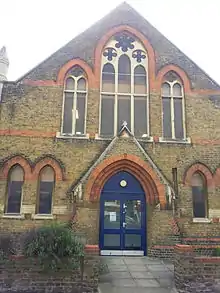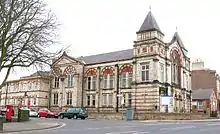Charles Bell (British architect)
Charles Bell FRIBA[1] (1846–99) was a British architect who designed buildings in the United Kingdom, including over 60 Wesleyan Methodist chapels.[2]
Charles Bell | |
|---|---|
.jpg.webp) Bermondsey Central Hall, Bermondsey Street | |
| Born | 1846 |
| Died | 1899 |
| Nationality | British |
| Alma mater | Pupil of John Giles |
| Occupation | Architect |
| Awards | FRIBA[1] |
| Buildings | Holme School, Grimsby, Kent College Canterbury and Darwen Town Hall. |
| Projects | John Wesley Memorial Church and buildings, Epworth, Lincolnshire. |
Career
Bell, who was born in 1846 and came from Bourne in Lincolnshire,[3] was educated at Grantham Grammar School.[2] He was articled to the London architect John Giles.[4] In 1870 he was elected an Associate of the Royal Institute of British Architects and started independent practice.[5] In 1888 he was working from Dashwood House, 9 New Broad Street, London.
His works include:
Commercial buildings
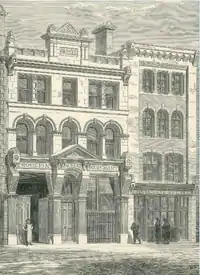
- Bacon Warehouse and Smokery, 42 & 44–46 St. John Street, Islington, London (1877)[4] Warehouses. No. 42 for Dillamore & Rowley, cork manufacturers, Nos 44–46 for Edward Richard Parker, provision merchant. Nos 44–46. shows the ground floor with embellishments in Portland stone, with polished granite pilasters. The upper part, faced in Bath stone. At the back was a bacon smoking warehouse.[8]

- New Warehouse, Ludgate Square, London for Messrs. Fourdrinier, Hunt and Co. 1878. Wholesale Paper Merchants.[9]
Schools
- Kent College (Wesleyan College), Canterbury, Kent (1885)[6] Boy's Methodist Public School.
- Fairfields Primary School, Basingstoke.(1887). Red brick with filling-in of knapped flint work characteristic of the district. Bell described the school as Queen Anne, modified to suit their special purpose. There was ample light in each classroom by means of large windows; open fires heated the infants’ department, but innovative heating in the senior school was provided by a hot water boiler supplying radiating coils.[10]
- Mawney Primary School, Mawney Road, Romford, Essex. (1896), Nicely scaled with pitched roofs, tile hanging, two-bay arched entrance.[11] Demolished and replaced in 2017.[12]
Children's holiday home
- Passmore Edwards Holiday Home for Children, Marine Parade, Clacton on Sea. 1898.[13] The Home later became a Convalescent Home and was demolished in 1986.
Cemetery layout and cemetery chapels
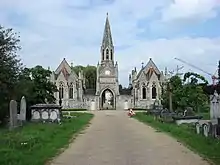
- Hampstead Cemetery. 1876. Bell designed the cemetery layout, lodges and cemetery chapels for the Hampstead Cemetery. For the double cemetery chapel with a central arch surmounted by a short spire he is either copying or modifying a design which was widely used in Lincolnshire and the Midlands by the Lincoln architects Bellamy and Hardy.
Methodist churches
- Vale Royal Methodist Church, Royal Tunbridge Wells, Kent (1873; closed 2015)[14]
- Rivercourt Methodist Church, King Street, Hammersmith, London (1875)[15]
- Roupell Park Methodist Church in Norwood Road, Lambeth (1879–80)[16]
- St Augustine in Baring Road, Grove Park, Lewisham (1885–86)[17]
- Southlands Methodist Church, York (1886–87)[18]
- Twickenham Methodist Church, Twickenham, London (1880)
- Leytonstone Methodist Church, Leytonstone, London (1880)[19]
- Ryde Methodist Church, Ryde, Isle of Wight (1883)[20]
- Ampthill Wesleyan Methodist Church, Bedfordshire opened 1884
- Trinity Wesleyan Methodist Church, Romford, Essex opened 1888
- Bermondsey Central Hall, South London Mission (1900: Bell's facade, which includes a Tudor gatehouse motif, was retained when the hall was rebuilt in 1968)[21]
Gallery of Methodist churches by Charles Bell
|
Work in Lincolnshire
Bell also had an office in the 1880s in Grimsby in Lincolnshire. Bell described himself as of London and Great Grimsby on his drawing of the Liberal Club in Grimsby published in The Building News, 21 November 1884.[22] His work in Lincolnshire included:
.jpg.webp)
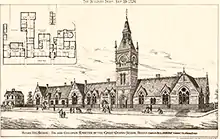
- Holme Hill School, Grimsby, Lincolnshire (1876). Corner of Heneage Road and Wellington Street.[6] The school was built for the Great Grimsby School Board to accommodate 1,165 children and cost £11,749. Over the entrance a central roundel bearing relief carving of the town seal with figures of Grim and Havelock the Dane, and above a stone band, inscribed “Great Grimsby Public Elementary Board School”. The School closed in 1967 and was extensively restored in 2014.[23]
- The Grimsby Fisherlads Institute. Building with a tower on a corner site. Later extended by the architect J. J. Creswell of Grimsby.[24]

- Duncombe Street Wesleyan Methodist Chapel, Grimsby (1873). Decorative brickwork with arched windows. Demolished in 1935 to make way for the Methodist Central Hall.[25]
- Star Lane School, Bourne (1876). Built for the Bourne School boards. The architect was Charles Bell of 4 Union Street, London and the contractors Messrs George and William Priest of Grantham at a cost of £3,727. Single storey building with projecting wings and central projection with the armorial of the School Board above the window, and two porches on either side. Gothic pointed windows with yellow and red brick. Red brick stringing. The school is now Bourne Abbey Church of England Primary Academy.[26]
- Wesleyan Chapel, Mavis Enderby. (1877)[27]
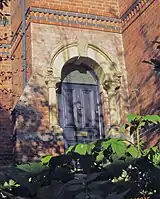
- 1 Temple Garden, Lincoln. House designed by Charles Bell for Mrs Whelpton in 1877.[28]
- Methodist Chapel, Spilsby. (1877–8). Described as stock brick with geometrical tracery and no tower.[29] The two manses on either side of the Chapel were also designed by Bell.
- Methodist Chapel, Algitha Road, Skegness. (1881)[27]
- The Liberal Club, Central Market Place. Grimsby.(1884)[30] The building ceased as a Liberal Club in 1899. Possibly destroyed in Second World War.

.jpg.webp)
- The Wesley Memorial Church, School and Manse, Epworth (1888–9).[27]
- Bourne. Corn Exchange 3 Abbey Road. (1870). Built for the Bourne Public Hall and Corn Exchange Company Limited. The contract for the construction work went to Robert Young of Lincoln in May 1870, after his tender of £1,150 was accepted. The Corn Exchange was substantially extended and re-built in 1990 [33]
Notes and references
- "Bell, Charles (1846–99)". Archiseek. 7 June 2009. Retrieved 9 June 2014.
- "Charles Bell". Dictionary of Scottish Architects. Retrieved 9 June 2014.
- His father was Henry Bell, an accountant: "White's Lincolnshire", 1856, pg.707
- Historic England. "Bacon Smokehouse (1419034)". National Heritage List for England. Retrieved 27 March 2016.
- Brodie, Antonia (2001). Royal Architectural Library, Royal Institute of British Architects: Directory of British Architects 1834–1914, vol.1. New York: Continuum. ISBN 0-8264-5513-1.
- "Charles Bell". Archiseek. Retrieved 9 June 2014.
- "1879 – Selected design for Public Market, Over Darwen, Lancashire". Archiseek. Retrieved 9 June 2014.
- Survey of London
- The Building News ~ May.10th.1878
- Victoria County History Hampshire
- Cherry B et al (2005), Buildings of England: London 5: East pg 226
- Anderson, Hayley (8 September 2016). "Romford headteacher looks to the future as 120-year-old school is set to be demolished and rebuilt". Romford Recorder.
- The Building News, May 20, 1898
- "History". Vale Royal Methodist Church, Tunbridge Wells. 2017. Archived from the original on 2 July 2017. Retrieved 4 July 2017.
- Cherry, Bridget and Pevsner, Nikolaus (1 March 1991). London 3: North West. Yale University Press. p. 56. ISBN 978-0-300-09652-1. Retrieved 27 March 2016.CS1 maint: multiple names: authors list (link)
- Cherry, Bridget and Pevsner, Nikolaus (1983). The Buildings of England – London 2: South. London: Penguin Books. p. 340. ISBN 0-14-0710-47-7.CS1 maint: multiple names: authors list (link)
- Cherry, Bridget and Pevsner, Nikolaus (1983). The Buildings of England – London 2: South. London: Penguin Books. p. 413. ISBN 0-14-0710-47-7.CS1 maint: multiple names: authors list (link)
- "New Wesleyan Chapel in York". York Herald. York. 14 October 1887. Retrieved 18 June 2015.
- "1876 to 1976". Who We Are. Leytonstone Methodist Church. Archived from the original on 2016-04-07. Retrieved 27 March 2016.
- Lloyd, David W.; Pevsner, Nikolaus (2006). The Isle of Wight. The Buildings of England. London: Yale University Press. p. 227. ISBN 978-0-300-10733-3.
- Cherry, Bridget and Pevsner, Nikolaus (1983). The Buildings of England – London 2: South. London: Penguin Books. p. 601. ISBN 0-14-0710-47-7.CS1 maint: multiple names: authors list (link)
- Pevsner refers to Bell of Grimsby not apparently realising that he was the same architect as the London architect. "Antram" (1989), pg 69.
- Grimsby Telegraph
- Chapman P.(1993) Images of North Lincolnshire, Breedon Books, Derby,pg.20, ill.ISBN 1873626649
- Chapman P.(1993) Images of North Lincolnshire, Breedon Books, Derby,pg.51, ill.ISBN 1873626649
- http://www.bourneabbey.lincs.sch.uk/page/?title=1877&pid=55
- ‘‘Antram’’ (1989), pg 272
- Lincoln City Building application no. 845. 3 Drawings.
- ‘‘Antram’’ (1989), pg. 681
- The Building News, November 21st 1884. ,
- Front Perspective published in The Architect, April 13th 1888.
- "Antram" (1989), pg 502
- https://www.bournelocal.co.uk/news/looking-back-at-the-changing-face-of-the-town-s-corn-exchange-1-4929874 Archived 2018-03-22 at the Wayback Machine.
| Wikimedia Commons has media related to Charles Bell (British architect). |
Sources
- Antram N (revised), Pevsner N & Harris J, (1989), The Buildings of England: Lincolnshire, Yale University Press.
- Antonia Brodie (ed), Directory of British Architects, 1834–1914: 2 Vols, British Architectural Library, Royal Institute of British Architects, 2001, Vol 1, pg. 154.

.jpg.webp)
.jpg.webp)
.jpg.webp)

